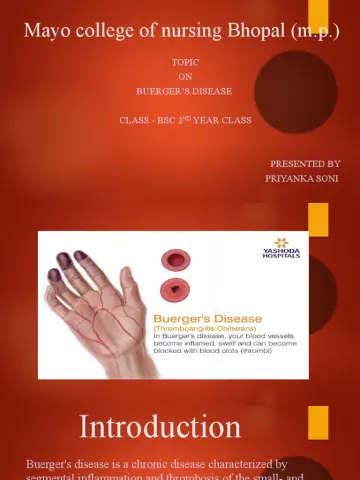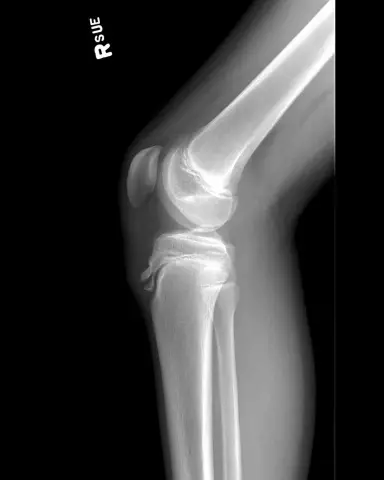- Author Rachel Wainwright [email protected].
- Public 2023-12-15 07:39.
- Last modified 2025-11-02 20:14.
Werlhof's disease
The content of the article:
- Causes and risk factors
- Forms of the disease
- Symptoms
- Diagnostics
- Treatment
- Possible complications and consequences
- Forecast
Werlhof's disease is the historical name for a blood disorder now known as idiopathic thrombocytopenic purpura.

Skin manifestations of Werlhof disease
The symptoms of pathology were first noted before the new era, they were described in detail in his writings by Hippocrates. In 1735, Paul Gottlieb Werlhof combined the symptoms of the disease into a separate nosological unit, calling it “spotted hemorrhage disease”. The scientist pointed out the predominant susceptibility to painful manifestations of young women and described cases of spontaneous recovery.
Idiopathic thrombocytopenic purpura is a disease manifested by an isolated immune-mediated decrease in platelet count (less than 100 x 10 9 / L), occurring for no apparent reason, with or without hemorrhagic syndrome.
This is the most common immune pathology of the blood: it occurs in children and adults with a frequency of 16-39 cases (according to other sources, 50-100) per 1 million per year. Mostly women are sick (the incidence among men is 3-4 times less, in adulthood the difference increases to 5-6 times).
The average age of patients is 20-40 years (over 50%), in the period from 40 to 60 years, the disease occurs in 20% of cases, rarely occurs in people over 70 and under 20 years of age.
In 2009, the journal Blood, published by the American Society of Hematology, published guidelines for the terminology, diagnosis, and treatment of the disease, developed by a team of experts from several international conferences. In the published materials, it is proposed to designate the disease as immune (primary) thrombocytopenic purpura; this term is also used in the Federal clinical guidelines presented by the Hematological Research Center of the Ministry of Health of Russia.
Synonyms: idiopathic thrombocytopenic purpura, immune thrombocytopenic purpura, immune thrombocytopenia, primary immune thrombocytopenia.
Causes and risk factors
The leading role in the development of the disease is played by immune disorders in the body that arose without previous pathology. Immune failure is manifested by the following changes:
- violation of platelet formation in the red bone marrow;
- defect in recognition of receptors of own platelets;
- an error in the recognition of platelet precursors - megakaryocytes;
- production of antibodies (autoantibodies) to cells determined by the immune system as foreign;
- massive destruction of platelets and megakaryocytes.

With Werlhof disease, platelet formation in the bone marrow is impaired
In secondary immune thrombocytopenia, the interaction of autoantibodies with thrombotic or megakaryocytes occurs against the background of the presence of autoimmune pathology (systemic lupus erythematosus, antiphospholipid syndrome, etc.) - this distinguishes it from Werlhof's disease, which occurs primarily.
The provoking factors of Werlhof's disease:
- previous viral, less often bacterial infections (about 60% of all cases);
- pregnancy;
- psycho-emotional stressful effects;
- medical or diagnostic surgery;
- intense physical activity;
- previous vaccination.
Forms of the disease
The main forms of Werlhof's disease:
- first detected (limitation period - no more than 3 months from the date of diagnosis);
- protracted or persistent (the period from diagnosis is from 3 months to a year, in the absence of spontaneous or stable drug remission);
- chronic (disease experience - more than 1 year), occurs in 10-15% of cases.
By the nature and severity of hemorrhagic syndrome (classification of the World Health Organization):
- grade 0 - no bleeding;
- grade 1 - single petechiae and single ecchymosis;
- grade 2 - moderate bleeding (diffuse petechiae +> 2 ecchymosis in one region - trunk, head and neck, upper or lower extremities);
- grade 3 - severe bleeding (bleeding of mucous membranes and other types);
- grade 4 - debilitating blood loss.
According to the severity of the course during the initial treatment of the patient, 3 degrees of severity of the disease are distinguished:
- Mild form - without thrombocytopenic hemorrhagic manifestations or with them, but not more often than 1 time per year (grade 0 or 1 according to WHO).
- Moderate severity - pronounced hemorrhagic syndrome 1-2 times a year, quickly controlled by therapy (grade 2 according to WHO).
- Severe form - 3 or more exacerbations per year, leading to the patient's disability (grades 3-4 according to WHO).
Refractory thrombocytopenia is distinguished separately - in the absence of effect and recurrence of the disease even after the use of surgical methods of treatment.
Symptoms
The disease may be asymptomatic; the only sign of immune thrombocytopenia in this case will be abnormal laboratory parameters.
In the presence of clinical manifestations, the main symptoms are as follows:
- punctate petechial rash;
- bruising arising from minor traumatic effects or spontaneous;
- nose, gingival, uterine bleeding;
- the appearance of traces of blood in the stool;
- tarry stools, vomiting of coffee grounds;
- in women - profuse prolonged menstruation, intermenstrual bleeding;
- pink coloration of urine.

Bruising with Werlhof disease
The frequency of bleeding in brain structures that threaten the patient's life does not exceed 0.5-1%; such hemorrhages develop with a critically low platelet count in the blood.
Diagnostics
Primary immune thrombocytopenia is a diagnosis of exclusion, that is, it is confirmed by the absence of other diseases and conditions that can provoke a decrease in the number of platelets less than 100 x 10 9 / L in 2 or more blood tests (taking certain drugs, conditions after blood transfusion, pseudothrombocytopenia, myelodysplastic syndromes, concomitant autoimmune diseases, lymphoproliferative disorders, etc.).

Decreased platelet count suggests Werlhof disease
Basic diagnostic techniques:
- collection of anamnesis (previous provoking factors, burdened heredity, episodes of bleeding);
- a general blood test (an isolated decrease in the number of platelets is detected along with normal indicators of hemoglobin, erythrocytes and reticulocytes, leukocytes and leukocyte counts and the absence of morphological and functional abnormalities of the formed elements);
- microscopy of peripheral blood smears (for the absence of abnormal cells);
- blood chemistry;
- trepanobiopsy of the bone marrow with cytological examination of the material (when other hematological disorders are detected in the patient and for patients of atypical age groups);
- expanded coagulogram with thrombocytopenia less than 50 x 10 9 / l;
- detection of specific antibodies to platelet glycoproteins.
Treatment
The main goal of treatment for immune thrombocytopenia is not to bring blood counts to normal values, but to achieve a safe platelet level, preventing or stopping hemorrhagic syndrome.
The normal number of platelets ranges from 150-450 x 10 9 / l (depending on ethnicity, age, external influences). Platelets at the level of 100 x 10 9 / L fully provide adequate hemostasis, allowing surgical interventions and delivery without the risk of bleeding. Dangerous in relation to the development of severe bleeding is the level of platelets below 10 x 10 9 / l.
The level of platelets above 30-50 x 10 9 / L is considered safe, which ensures an adequate quality of life without the risk of developing spontaneous bleeding.
Medicines used in the treatment of primary immune thrombocytopenia:
- vaso-strengthening agents;
- glucocorticosteroid hormones;
- polyvalent intravenous immunoglobulin;
- immunosuppressive drugs;
- thrombopoietin receptor agonists.

Removal of the spleen or splenectomy is indicated in the absence of a positive effect of drug therapy
In the case of resistance to therapy with glucocorticosteroids, splenectomy (removal of the spleen) is indicated.
Possible complications and consequences
The main complications of Werlhof's disease are bleeding of various localization, as well as dysfunction of the central nervous system as a result of hemorrhage.
The mortality rate in primary immune thrombocytopenia is extremely low - about 0.1%. The causes of death are usually hemorrhages in the structures of the brain, severe post-hemorrhagic anemia.
Forecast
In most patients (85-90%), spontaneous normalization of the state (spontaneous remission) occurs within several months (up to six months).
The transition of the process to a chronic form occurs in 10-15% of cases.
Dispensary observation of patients with newly diagnosed disease is carried out for at least 2 years.

Olesya Smolnyakova Therapy, clinical pharmacology and pharmacotherapy About the author
Education: higher, 2004 (GOU VPO "Kursk State Medical University"), specialty "General Medicine", qualification "Doctor". 2008-2012 - Postgraduate student of the Department of Clinical Pharmacology, KSMU, Candidate of Medical Sciences (2013, specialty "Pharmacology, Clinical Pharmacology"). 2014-2015 - professional retraining, specialty "Management in education", FSBEI HPE "KSU".
The information is generalized and provided for informational purposes only. At the first sign of illness, see your doctor. Self-medication is hazardous to health!






